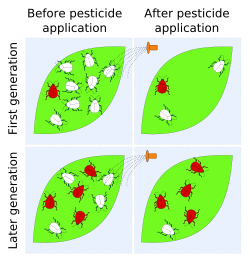Our website is made possible by displaying online advertisements to our visitors.
Please consider supporting us by disabling your ad blocker.
Pesticide resistance

Pesticide resistance describes the decreased susceptibility of a pest population to a pesticide that was previously effective at controlling the pest. Pest species evolve pesticide resistance via natural selection: the most resistant specimens survive and pass on their acquired heritable changes traits to their offspring.[1] If a pest has resistance then that will reduce the pesticide's efficacy – efficacy and resistance are inversely related.[2]
Cases of resistance have been reported in all classes of pests (i.e. crop diseases, weeds, rodents, etc.), with 'crises' in insect control occurring early-on after the introduction of pesticide use in the 20th century. The Insecticide Resistance Action Committee (IRAC) definition of insecticide resistance is 'a heritable change in the sensitivity of a pest population that is reflected in the repeated failure of a product to achieve the expected level of control when used according to the label recommendation for that pest species'.[3]
Pesticide resistance is increasing. Farmers in the US lost 7% of their crops to pests in the 1940s; over the 1980s and 1990s, the loss was 13%, even though more pesticides were being used.[1] Over 500 species of pests have evolved a resistance to a pesticide.[4] Other sources estimate the number to be around 1,000 species since 1945.[5]
Although the evolution of pesticide resistance is usually discussed as a result of pesticide use, it is important to keep in mind that pest populations can also adapt to non-chemical methods of control. For example, the northern corn rootworm (Diabrotica barberi) became adapted to a corn-soybean crop rotation by spending the year when the field is planted with soybeans in a diapause.[6]
As of 2014[update], few new weed killers are near commercialization, and none with a novel, resistance-free mode of action.[7] Similarly, as of January 2019[update] discovery of new insecticides is more expensive and difficult than ever.[8]
- ^ a b PBS (2001), Pesticide resistance. Retrieved on September 15, 2007.
- ^ Guedes, R.N.C.; Smagghe, G.; Stark, J.D.; Desneux, N. (2016-03-11). "Pesticide-Induced Stress in Arthropod Pests for Optimized Integrated Pest Management Programs". Annual Review of Entomology. 61 (1). Annual Reviews: 43–62. doi:10.1146/annurev-ento-010715-023646. ISSN 0066-4170. PMID 26473315. S2CID 207747295.
- ^ "Resistance Definition". Insecticide Resistance Action Committee. 2007.
- ^ Grapes at Missouri State University (MSU) How pesticide resistance develops Archived 2007-08-17 at the Wayback Machine. Excerpt from: Larry Gut, Annemiek Schilder, Rufus Isaacs and Patricia McManus. Fruit Crop Ecology and Management, Chapter 2: "Managing the Community of Pests and Beneficials." Retrieved on September 15, 2007.
- ^ Miller GT (2004), Sustaining the Earth, 6th edition. Thompson Learning, Inc. Pacific Grove, California. Chapter 9, Pages 211-216.
- ^ Levine, E; Oloumi-Sadeghi, H; Fisher, JR (1992). "Discovery of multiyear diapause in Illinois and South Dakota Northern corn rootworm (Coleoptera: Cerambycidae) eggs and incidence of the prolonged diapause trait in Illinois". Journal of Economic Entomology. 85: 262–267. doi:10.1093/jee/85.1.262.
- ^ Service, Robert F. (20 September 2013). "What Happens When Weed Killers Stop Killing?". Science. 341 (6152): 1329. doi:10.1126/science.341.6152.1329. PMID 24052282.
- ^ Guedes, R. N. C.; Roditakis, E.; Campos, M. R.; Haddi, K.; Bielza, P.; Siqueira, H. A. A.; Tsagkarakou, A.; Vontas, J.; Nauen, R. (2019-01-31). "Insecticide resistance in the tomato pinworm Tuta absoluta: patterns, spread, mechanisms, management and outlook". Journal of Pest Science. 92 (4). Springer: 1329–1342. doi:10.1007/s10340-019-01086-9. ISSN 1612-4758. S2CID 59524736.
Previous Page Next Page


